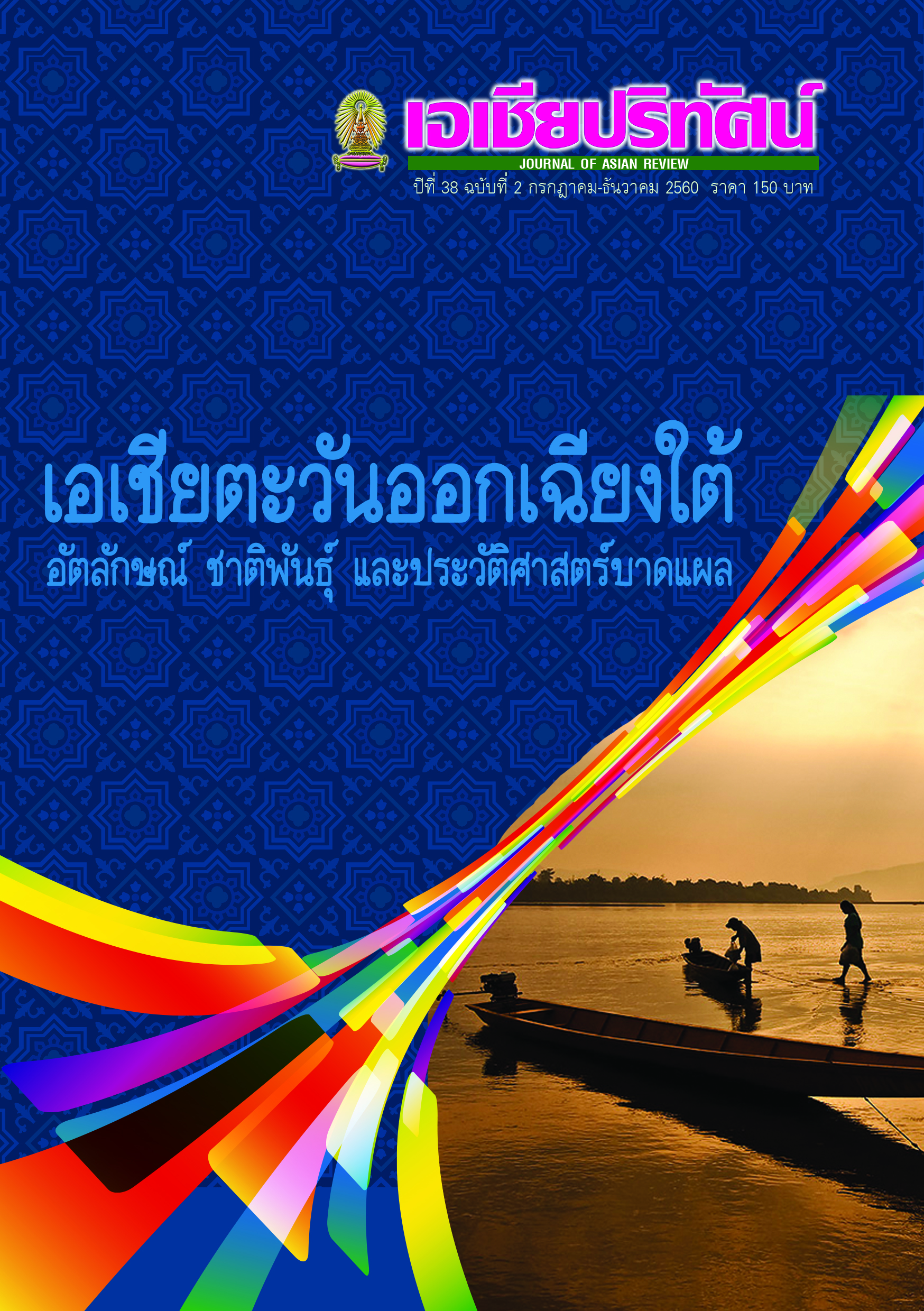Borderless Violence Involving Transnational Migrants: The Case Study of the Uighur from Xinjiang
Main Article Content
Abstract
Over the past few years, Thailand has been experiencing a number of violent incidents involving transnational migrants, including the Uighur from Xinjiang, China. The violence has taken place both in Thailand and elsewhere. The violent incident in Thailand was the explosion in the Ratchaprasong area, which lies in the heart of Bangkok. The case on this incident is still in the process of legal action against the accused, who are all Uyghur. The violence outside Thailand was the destruction of the Consulate-General office of Thailand in Istanbul, Turkey. This incident still remains puzzling to the Thai people in general: who are the Uyghur? Where did they come from? Why did they commit violence in Thailand? This research article aims to answer those questions, and also to find appropriate ways to deal with transnational migrants. The study found that the Uighur people have a history of their own for thousands of years. Later, they were adversely affected by various policies of the Chinese government, such as those restricting the freedom of religious practice, imposing discrimination, violating human rights, and also exploiting the economic and resource interests in the area. The Uighur have thus been so unhappy, and some of them have tried to resist the Chinese central government and moved to other countries. Thailand has become a target country being used by the Uighur migrants as a passage to some other countries. Therefore, the Thai government needs to take appropriate measures to maintain a balance in the treatment of this group to avoid complications which may affect the country’s long-term national interests.
Article Details
References
1. กระทรวงการต่างประเทศ. 2558 ก. “ข่าวสารนิเทศ: กรณีการส่งกลับผู้ลักลอบเข้าเมืองชาวมุสลิมที่อ้างว่าเป็นชาวตุรกี (ชาวอุยกูร์).” กระทรวงการต่างประเทศ. เข้าถึงเมื่อ 30 ตุลาคม 2559. http://www.mfa.go.th/main/th/media-center/14/58151
2. กระทรวงการต่างประเทศ. 2558 ข. “ข่าวสารนิเทศ: เหตุระเบิดที่แยกราชประสงค์ เมื่อวันที่ 17 สิงหาคม 2558 (ฉบับที่ 2).” กระทรวงการต่างประเทศ. เข้าถึงเมื่อ 30 ตุลาคม 2559. http://www.mfa.go.th/main/th/media-center/14/5920
3. สถานเอกอัครราชทูตไทย ณ กรุงอังการา. 2558. “ขอให้คนไทยในตุรกีเพิ่มความระมัดระวังตัว.” สถานเอกอัครราชทูตไทย ณ กรุงอังการา. เข้าถึงเมื่อ 30 ตุลาคม 2559. URL: http://thaiembassyturkey.com/th/news-3/338
ภาษาอังกฤษ
4. Austrian Red Cross. 2016. “China: Situation of Uyghurs.” Austrian Centre for Country of Origin and Asylum Research and Documentation.
5. Bovingdon, Gardner. 2010. The Uyghurs: Strangers in Their Own Land. New York: Columbia University Press.
6. Campbell, Charlie. 2017. “Pipelines, and Geopolitics: China’s New Silk Road Is a Challenge for Washington.” Time, Accessed October 23, 2017. URL: http://time.com/4992103/china-silk-road-belt-xi-jinping-khorgos-kazakhstan-infrastructure/
7. Gladney, Dru. 2004. Dislocating China: Reflections on Muslims, Minorities, and Other Subaltern Subjects. Chicago: The University of Chicago Press.
8. Gladney, Dru. 2008 “Islam and Modernity in China: Secularization or Separatism?” In Chinese Religiosities: Afflictions of Modernity and State Formation, edited by Mayfair Yang, California: University of California Press.
9. Howell, Anthony and C. Cindy Fan. 2011. “Migration and Inequality in Xinjiang: A Survey of Han and Uyghur Migrants in Urumqi.” Eurasian Geography and Economics 52 (1): 119–139.
10. Jack Chen. 1977. The Sinkiang Story. New York: Macmillan Publishing.
11. Lefevre, Amy Sawitta and Yesim Dikmen. 2015. “Thai PM defends decision to send Uighurs back to China.” Reuters, Accessed 29 July 2016. https://www.reuters.com/article/us-thailand-uighurs-turkey/thai-pm-defends-decision-to-send-uighurs-back-to-china-idUSKCN0PJ18620150709
12. Legerton, Colin and Jacob Rawson. 2009. Invisible China: a Journey through Ethnic Borderlands. Chicago: Chicago Review Press.
13. Lipman, Jonathan. 2009. “Jonathan Lipman on Ethnic Tension in China.” Mount Holyoke College, Accessed 2 August 2016. https://www.mtholyoke.edu/ media/jonathan-lipman-ethnic-tension-china-0
14. Potter, Robert. 2015. “Why Thailand Returned the Uyghurs.” The Diplomat, Accessed 2 August 2016. http://thediplomat.com/2015/08/what-thailand-returned-the-uyghurs/
15. Holdstock, Nick. 2014. “Islam and Instability in China’s Xinjiang.” Norwegian Peacebuilding Resource Centre Report.
16. Irwin, Peter. 2017. 2016 Human Rights Situation in East Turkestan. The World Uyghur Congress.
17. Schichor, Yitzhak. 2009. Ethno-Diplomacy: The Uyghur Hitch in Sino-Turkish Relation. Honolulu: Policy Study, East-West Center.
18. Starr, S. Frederick. ed. 2004. Xinjiang: China’s Muslim Borderland. New York: Central Asia Caucasus Institute.
19. Yu-Wen Chen. 2010. “Who Made Uyghurs Visible in the International Arena?: A Hyperlink Analysis.” Global Migration and Transnational Politics Working Paper Number 12. June 2010. George Mason University.
20. Yu-Wen Chen. 2012. “A Network Approach to the Study of the World Uyghur Congress’ Global Outreach: A Methodological Note.” Journal of Chinese Political Science 17 (1): 77-88.
21. Xiaogang Wu and Xi Song. 2013. “Ethnicity, Migration, and Social Stratification in China: Evidence from Xinjiang Uyghur Autonomous Region.” Population Studies Center Research Report No. 13-810. November 2013. Institute for Social Research, University of Michigan.
22. Wickenkamp, Carol. 2014. “Uyghurs ‘Caged’ by Internet Restrictions, Charges Report.” The Epoch Times. Accessed June 16, 2014. https://www.theepochtimes.com/uhygurs-caged-by-internet-restrictions-charges-report_740885.html
23. World Uyghur Congress. 2014. 2014 Report on Human Rights Violations in East Turkistan. World Uyghur Congress.
24. Zenn, Jacob. 2014. “Undocumented Uyghur Migrants Find New Route to Southeast Asia.” China Brief 14 (17): 8-11.


